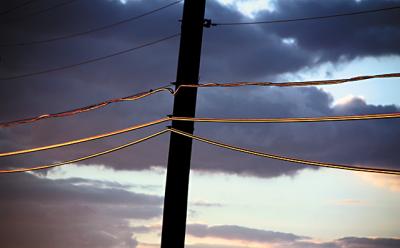PSEG to Strengthen Poles Throughout Town

Officials from PSEG Long Island this week outlined their plan to begin replacing utility poles throughout East Hampton as part of a federally funded project to strengthen the electric grid across Long Island.
About 25 percent of the poles in East Hampton holding distribution lines — the smaller poles that hold wires connecting to individual houses — are to be replaced with new ones “a little bit wider, a little bit taller, and better able to withstand winds” of up to 130 miles per hour, Chris Hahn, a director of external affairs for PSEG, said at a town board meeting on Tuesday.
The new poles will be two to three inches wider and three to five inches taller than the ones they replace, and will be seated deeper into the ground for strength. They will be treated with a wood preservative, either chromated copper arsenate (C.C.A.) or pentachlorophenol, the chemical known as penta.
Work has been under way for the last year in every other Long Island town as well as in the Rockaways.
The project to restore and strengthen more than 1,000 miles of overhead electric lines across Long Island received Federal Emergency Management Agency funding after the PSEG Long Island service area was declared a federal major disaster area following Hurricane Sandy, when 1.1 million Long Islanders were without power.
Some of the circuits most in need of upgrades are in East Hampton, with a number of the utility poles in the town some 40 or 50 years old, Mr. Hahn said.
While the utility does not require the approval of the town board for the work, company officials approached Town Supervisor Larry Cantwell before initiating the upgrades here, perhaps with the vocal opposition of numerous residents to its last project in East Hampton in mind.
A new, six-mile high-voltage transmission line that entailed the installation of large, wood, penta-treated poles along the route from East Hampton Village to Amagansett prompted protests and lawsuits. Concerns about the environmental impact of penta, which has been banned in countries around the world, were a primary element in the fight against the new high-voltage poles.
The new effort is “a maintenance project,” Mr. Hahn said Tuesday. “We are replacing equipment that is likely to fail.”
“This is good, an upgrade,” Mr. Hahn told the board. “This is good for your constituents.”
“But,” he said, “if there is a substantial objection we don’t have to do this here.”
Town Supervisor Larry Cantwell asked Mr. Hahn if PSEG would consider the use of composite poles made of fiberglass and similar materials rather than wood.
“We’ve already evaluated the composite situation,” said Mr. Hahn. “It’s just not an option for this project.” The increased cost of the composite poles would reduce the scope of the work that can be completed with the FEMA money, he said.
Helene and Jack Forst, East Hampton residents who led the fight against the high-voltage line installation, attended Tuesday’s meeting and questioned the utility’s plans, urging PSEG to use composite poles here as a pilot program.
A bill banning the use of penta is under consideration by the New York State Legislature, Ms. Forst pointed out.
Mr. Forst said that although composite poles might cost more at the outset, they will last longer than wooden poles and can better withstand storm winds. They would also avoid “pollution of our groundwater,” he said. “I don’t know what 25 percent of the poles is,” he said, “but it’s a substantial amount” to be installing new poles treated with a chemical “banned in many parts of the world.”
“I’d like to see some progressive thinking to make a change in our town,” he said.
The bolstering of the electrical system will include installation of surge arrestors and stronger cross-arms as well as covering wires, trimming trees, and replacing the poles along main distribution lines.
Mr. Hahn said that removal of the old poles would be coordinated with the other utility companies that have equipment on them, and that the project will not be considered complete until the “double wood” is removed.
Installation of automated switches that can be operated remotely “will help us maintain power in minor storms, and help us restore power quickly after major storms like Hurricane Sandy,” Mr. Hahn said.
The upgrades are expected to be finished by 2018 or ’19.
Also at the meeting on Tuesday, Mr. Hahn addressed concerns raised about the appearance of PSEG’s substation on Old Stone Highway in Amagansett, where equipment is being installed to serve the new high-voltage transmission lines.
The company has promised to install landscaping to shield the site, which is enclosed by a chain-link fence. However, “we’re past the planting season,” Mr. Hahn said. The substation work will be finished and the equipment is expected to be in service by the end of the summer. Then the plantings will be installed.
